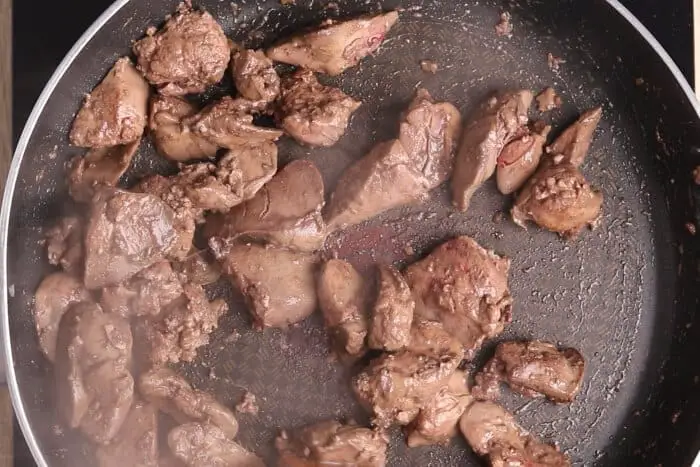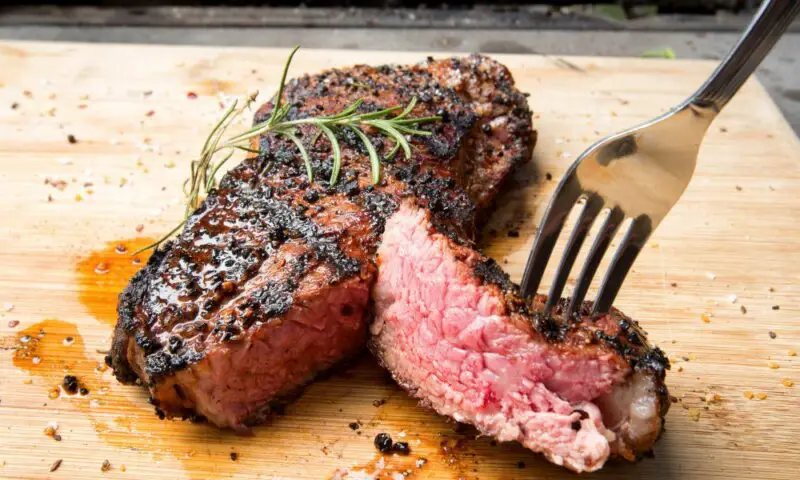According to experts, a cooked gammon joint can be safely stored in the fridge for up to 3-4 days. This timeframe ensures that the gammon remains fresh and maintains its taste and quality. It is important to properly store the cooked gammon in an airtight container or wrap it tightly in aluminum foil to prevent any contamination or moisture loss. Keeping the cooked gammon in the fridge at a temperature below 40°F (4°C) is crucial to avoid any bacterial growth or spoilage. It is recommended to consume the gammon within the designated timeframe to ensure its safety and optimal flavor.
Key Takeaways:
- A cooked gammon joint can be kept in the fridge for 3-4 days.
- Properly store the gammon in an airtight container or wrapped tightly in aluminum foil.
- Keep the fridge temperature below 40°F (4°C) to prevent bacterial growth.
- Consume the gammon within the designated timeframe for safety and flavor.
Storing Cooked Gammon Joint in the Fridge
When it comes to storing a cooked gammon joint in the fridge, proper food safety practices are crucial. Here are some important tips to ensure the freshness and quality of your cooked gammon:
- Store in an airtight container: Place the cooked gammon joint in a sturdy, airtight container to protect it from any potential contamination. This will also help to maintain its moisture and prevent it from drying out.
- Wrap tightly in aluminum foil: If you don’t have an airtight container, you can tightly wrap the cooked gammon joint in aluminum foil. This will provide an extra layer of protection against bacteria and help to retain its flavor.
- Label with date and contents: Always remember to label the container or foil package with the date of storage and the contents. This will help you keep track of how long the gammon has been in the fridge and prevent any confusion.
- Place on a lower shelf: To ensure proper air circulation in the fridge, it’s best to store the cooked gammon joint on a lower shelf rather than in the door. This will help maintain a consistent temperature and minimize the risk of spoilage.
- Keep at a temperature below 40°F (4°C): It’s important to keep the fridge temperature below 40°F (4°C) to prevent the growth of harmful bacteria. Use a refrigerator thermometer to monitor the temperature and make adjustments if necessary.
By following these guidelines, you can safely store your cooked gammon joint in the fridge and enjoy it for up to 3-4 days while ensuring its quality and taste.
Table: Proper Storage Guidelines for Cooked Gammon Joint
| Storage Method | Recommendation |
|---|---|
| Airtight container | Preferred method for storing cooked gammon joint in the fridge |
| Aluminum foil | Effective alternative for wrapping and preserving the gammon |
| Labeling | Important for proper tracking and identification |
| Shelf placement | Lower shelf for optimal air circulation and consistent temperature |
| Temperature control | Keep fridge temperature below 40°F (4°C) to prevent bacterial growth |
Checking the Quality of Cooked Gammon Joint
Before consuming a cooked gammon joint that has been stored in the fridge, it is important to check its quality. Here are a few signs to look out for:
Appearance
Inspect the cooked gammon joint for any noticeable changes in appearance. It should still retain its appetizing color and texture. If the gammon appears discolored, dry, or has developed a slimy film, it may indicate spoilage and should not be consumed.
Smell
Give the cooked gammon joint a sniff. It should have a pleasant aroma that is characteristic of fresh and properly cooked meat. If you detect any unusual or foul odors, it is best to discard the gammon as it could be a sign of bacterial growth or spoilage.
Texture
When handling the cooked gammon joint, pay attention to its texture. It should be moist and tender. If the gammon feels overly dry or mushy, it may have lost its quality and taste. Additionally, if you notice any sliminess or stickiness on the surface, it is a clear indication that the gammon has spoiled.
By thoroughly examining the appearance, smell, and texture of the cooked gammon joint, you can ensure that it is safe to consume. Remember, if you have any doubts about its quality, it is always better to err on the side of caution and discard the gammon to avoid any potential foodborne illnesses.
| Signs of Quality | Signs of Spoilage |
|---|---|
| Appetizing color and texture | Discoloration |
| Pleasant aroma | Unusual or foul odors |
| Moist and tender texture | Overly dry or mushy texture |
Safe Practices for Reheating Cooked Gammon Joint
Reheating leftover cooked gammon joint can be a delicious way to enjoy this savory meat again. However, it is crucial to follow safe practices to avoid any potential foodborne illnesses. Here are some guidelines for reheating your cooked gammon joint:
- Thoroughly defrost: If your leftover gammon joint is frozen, make sure to defrost it in the refrigerator overnight before reheating. This ensures even heating and reduces the risk of bacterial growth.
- Reheat within two days: It is recommended to consume your leftover cooked gammon joint within two days of refrigeration. This timeframe ensures the best quality and safety of the meat.
- Use gentle heat: When reheating your gammon joint, opt for gentle heat methods such as low oven temperature or simmering on the stove. Avoid using high heat, as it can cause the meat to become dry and tough.
- Monitor the internal temperature: Use a food thermometer to ensure that the reheated gammon joint reaches an internal temperature of at least 165°F (74°C). This helps kill any bacteria that may have developed during storage.
By following these safe practices, you can enjoy your reheated cooked gammon joint with peace of mind, knowing that it is both delicious and safe to consume.
| Safe Practices for Reheating Cooked Gammon Joint | Temperature Guidelines |
|---|---|
| Defrosting | Thaw in the refrigerator overnight |
| Reheating timeframe | Within two days of refrigeration |
| Heat methods | Low oven temperature or simmering on the stove |
| Internal temperature | At least 165°F (74°C) |
Freezing Cooked Gammon Joint
If you have a cooked gammon joint that you want to store for an extended period, freezing it is a great option. Freezing helps to preserve the gammon’s freshness and flavor, allowing you to enjoy it even weeks or months later. Here are the steps to freeze cooked gammon:
- Allow the cooked gammon joint to cool completely before freezing. This helps to prevent the growth of bacteria.
- Wrap the gammon tightly in plastic wrap or aluminum foil. This will protect it from freezer burn and prevent any moisture loss.
- Place the wrapped gammon joint in a freezer-safe container or ziplock bag, removing as much air as possible. Proper packaging helps to maintain the gammon’s quality and prevent freezer odors from seeping in.
- Label the container or bag with the date of freezing. This will help you keep track of its storage time.
- Store the gammon joint in the freezer at a temperature of 0°F (-18°C) or below. It is advisable to use a freezer thermometer to ensure accurate temperature control.
When you’re ready to use the frozen gammon, thaw it in the refrigerator overnight. Once thawed, you can reheat it following safe practices for reheating cooked gammon joint, which we discussed in a previous section.
| Benefits of Freezing Cooked Gammon Joint | |
|---|---|
| Longer shelf life | By freezing the cooked gammon joint, you can extend its shelf life and enjoy it at a later time without worrying about it spoiling. |
| Convenience | Having frozen cooked gammon on hand can be convenient when you need a quick and delicious meal. It saves you time and effort in cooking from scratch. |
| Reduced food waste | Freezing cooked gammon joint allows you to make the most of your leftovers and reduces food waste. Instead of letting it go to waste, you can store it for future use. |
Remember, freezing can affect the texture of the gammon to some extent, so it may not have the exact same taste and texture as freshly cooked gammon. However, with proper storage and reheating, you can still enjoy a delicious meal with frozen cooked gammon joint.
Creative Ideas for Leftover Cooked Gammon Joint
When it comes to leftover cooked gammon, there’s no need to let it go to waste. With a little creativity, you can transform those leftover slices into delicious meals and snacks. Here are a few ideas to inspire you:
1. Gammon Sandwiches: Thinly sliced cooked gammon makes for a tasty filling in sandwiches. Layer it with fresh lettuce, juicy tomatoes, and a dollop of tangy mustard or mayo for a satisfying lunchtime treat.
2. Gammon Hash: Give your breakfast or brunch a flavor boost by adding diced cooked gammon to a hearty potato hash. Sauté onions, peppers, and diced potatoes in a skillet, then toss in the gammon and cook until everything is golden and crispy. Top it off with a fried or poached egg for a complete meal.
3. Gammon and Pea Risotto: Use your leftover cooked gammon to add a savory twist to a classic risotto. Sauté onions and garlic in olive oil, then add Arborio rice and cook until translucent. Gradually add warm chicken or vegetable broth, stirring constantly, until the rice is tender and creamy. Stir in diced gammon and peas for a delicious and comforting meal.
4. Gammon Quiche: Add a touch of elegance to your leftovers by incorporating them into a homemade quiche. Line a pie crust with cooked gammon, along with your choice of vegetables, cheese, and herbs. Whisk together eggs and cream, pour over the filling, and bake until golden and set. Serve with a side salad for a delightful lunch or dinner option.
These are just a few ideas to get you started. Feel free to let your culinary imagination run wild and experiment with your favorite flavors and ingredients. With a bit of creativity, your leftover cooked gammon can become the star of a brand-new culinary creation.
FAQ
How long will a cooked gammon joint keep in the fridge?
According to experts, a cooked gammon joint can be safely stored in the fridge for up to 3-4 days.
What is the best way to store a cooked gammon joint in the fridge?
It is important to properly store the cooked gammon in an airtight container or wrap it tightly in aluminum foil to prevent any contamination or moisture loss.
What temperature should the fridge be set at to store a cooked gammon joint safely?
Keeping the cooked gammon in the fridge at a temperature below 40°F (4°C) is crucial to avoid any bacterial growth or spoilage.
How can I check the quality of a cooked gammon joint stored in the fridge?
Before consuming a cooked gammon joint that has been stored in the fridge, it is important to check for any signs of spoilage or off-putting odors. Additionally, if the texture or color of the gammon appears abnormal, it is best to discard it.
What are the safe practices for reheating a cooked gammon joint?
When reheating a cooked gammon joint, it is important to ensure that it reaches an internal temperature of at least 165°F (74°C) to kill any harmful bacteria. This can be done by reheating it in the oven, microwave, or stovetop.
Can I freeze a cooked gammon joint?
Yes, freezing cooked gammon is an option to extend its shelf life. It is recommended to slice or portion the gammon before freezing it for easier thawing and use later on.
What are some creative ideas for using leftover cooked gammon?
Leftover cooked gammon can be repurposed in various delicious ways. Some ideas include using it in sandwiches, salads, omelettes, or as a topping for pizzas or pasta dishes.




